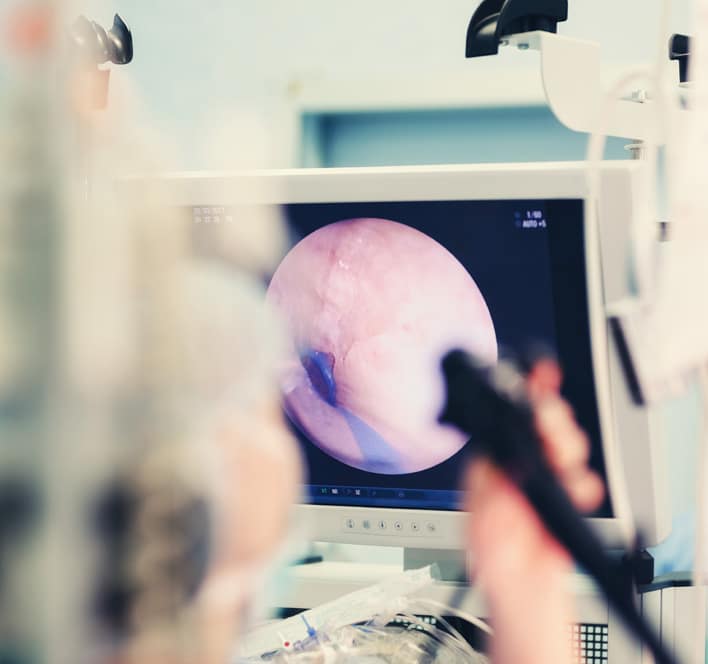When a spinal disc deteriorates, its gel-like center sometimes bulges outside of its usual space. If deterioration continues and a rupture occurs, disc fragments can irritate nerve roots, causing pain, numbness, and other symptoms. Many people with back conditions respond well to physical therapy, bed rest, and other pain management strategies. Others may require surgical interventions. When deciding which procedure is appropriate, for herniated disc relief, patients and their doctors usually consider the benefits of endoscopic discectomy vs. microdiscectomy.
If you have a deteriorated spinal disc and are not sure how to treat it, reach out to our team at NJ Spine & Orthopedic. Our Concierge Team can help you manage all aspects of your treatment plan and get you the help you need to treat back pain.
What Is Disc Deterioration?
When a disc deteriorates and ruptures, it’s usually a consequence of age-related lumbar disc disease. Disc problems can occur or worsen when a person experiences weight gain, lives a sedentary lifestyle, or when a typically inactive person participates in strenuous activities. While age is a primary factor in disc herniation, it may also occur due to severe accidental trauma, work-related heavy lifting, and activities that strain the spine.
Spinal deterioration problems may include bulging or ruptured discs, bony growths, or other issues. A person with lumbar disc difficulties may experience the following symptoms:
- Back pain
- Numbness or tingling in the leg or foot
- Muscle weakness in the legs
- Muscle spasms in the back
- Sciatica pain radiating down a leg
- Bowel or bladder changes
Most people with herniated discs improve with conservative treatment. Surgery sometimes becomes the best option when the pain is so overwhelming it interferes with their daily lives.
Endoscopic Discectomy vs Microdiscectomy
In many situations, orthopedic surgeons recommend disc decompression surgery only when nonsurgical options fail to control the pain. Patients and their doctors can choose either endoscopic discectomy or microdiscectomy based on doctor and patient preferences. Before committing to either of these procedures, there are several considerations to think about, including:
- What type of procedure does the orthopedic surgeon recommend?
- Is the surgery invasive or noninvasive?
- How long is the hospitalization after either surgery?
- Which surgery is most effective?
- What is the typical disability period for each surgery
- What are the direct and indirect costs?
While some of the post-surgery issues vary, both surgeries produced similar recovery outcomes.
What Is an Endoscopic Discectomy?
Endoscopic discectomy is a minimally-invasive surgery that patients usually undergo on an outpatient basis. To remain comfortable during the procedure, the patient requires only a local anesthetic and IV sedation. The orthopedic surgeon will create a small incision to insert a guidewire, a dilator, then a cannula.
The cannula is a small tubular device that forms an entryway for the endoscope. The endoscope incorporates specialized surgical instruments to remove deteriorating disc tissue. It also has a camera that allows the doctor to view the procedure on a monitor during the surgery. In most cases, the patient can return home on the same day of the surgery.
What Is a Microdiscectomy?
Before undergoing a microdiscectomy, the patient receives general anesthesia. To access the spine and the herniated area, the physician makes an incision on the patient’s back. To access the spinal canal, the doctor performs a laminectomy to remove portions of bone and tissue.
Beginning from the initial stages, a microdiscectomy is more invasive than endoscopic surgery. The doctor works through a larger incision and removes surrounding bone and tissue. Patients undergoing a microdiscectomy may bleed more. They also require a lengthier post-surgical recovery, so they usually remain hospitalized for one to two days following the procedure.
Evaluating Endoscopic Discectomy vs. Microdiscectomy Outcomes
The two surgeries have similar long-term outcomes. For microdiscectomy patients, the pain is more intense for several days immediately following the surgery. On the other hand, patients undergoing endoscopic discectomy surgeries required shorter rehabilitation periods.
Direct medical costs and indirect costs, such as lost income, are higher for microdiscectomy patients as well. Post-operative infections also occur more frequently in patients who undergo a microdiscectomy.
While it may seem like there are many downsides to a microdiscectomy, doctors consider this procedure a gold standard in spinal surgery. However, an endoscopic discectomy gives patients a viable alternative. Endoscopic discectomy is less invasive, more cost-efficient, and requires less recovery time. Endoscopic discectomy surgery is much newer, meaning that many doctors don’t have as much experience with this procedure. Meeting with your doctor to determine which treatment option works best for you is imperative before undergoing either one.
Get Relief From Disc Pain at the NJ Spine & Orthopedic
If you’re struggling to manage back pain, you deserve relief. When you contact NJ Spine & Orthopedic, we promise access to life-changing surgical solutions, advanced technologies, and state-of-the-art care. Our skilled surgeons specialize in endoscopic discectomy, microdiscectomy, and other surgical techniques. We can give you the focused attention and dedicated care you need for maximum recovery.
Our surgeons work to identify the source of your pain so that they can provide the right recovery solutions. If you’re dealing with a herniated disc or other painful back conditions, reach out to us through our contact form or call us at (866) 553-0612 to schedule a consultation today.

